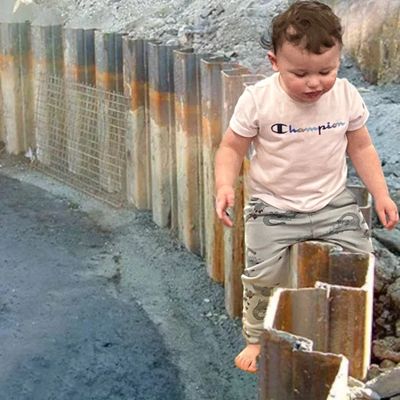Call: (267) 585-3921 for a quote
Sheet Piling Installation Methods and Tips
Sheet Piling Installation Options
Sheet piling can be installed using a variety of techniques including vibrating, impact driving, hydraulic pushing, jetting, and trenching. The type of project and sheet pile specification will often govern the method of installation.
There are many different types of driving hammers such as vibratory pile hammers, diesel, air-steam, hydraulic impact hammers, hydraulic sheet pile pushing rings, high pressure jets, or a simple drop hammer. Vibratory hammers have become the most common because of the fast installation time, fast extraction time, and they cause minimal damage to the pile and surrounding area. Vibratory hammers excel in soils that are granular. In harder/rockier terrain an impact hammer may be more efficient.
The invention of the hydraulic excavator mounted vibratory pile driver, with the ability to grab sheets from not only the top but the side via a "side grip", installation has become a far less specialized task and has opened the door to smaller companies. These units, along with smaller free hanging drivers from various manufacturers have revolutionized the industry.
Which hammer you select depends on the type of soil you are driving into. The engineers and project managers should be aware of the soil density and possible risks to the sheet pile which could cause failure or weakening of the joints during driving. Lighter weight sheet pile has become more common for residential bulkheads and retaining walls. Specialty air hammers are recommended for the more fragile material.
Placing guide structures or templates will ensure correct alignment of the sheet piles and should be used. Many companies would recommend using two templates to maintain other proper plumbness as well as driving the sheet piling sheets together as pairs. Sheet piling properly placed should be interlocked throughout their entire lengths.
Professor Bamm's Quick Tips:
1.You should always use a template system.
2. When driving long pairs of sheet piling the crane boom length should be at least twice that of the sheets.
3. Sheet pile should be driven with the male interlock leading in order to prevent fouling.
4. If the female interlock of the sheet pile must lead then a bolt or other object should be inserted to prevent fouling.
5. Align and perfectly plumb the first pair, drive carefully and accurately.
6. Drive sheets in pairs whenever possible, place the hammer in the center of the pair.
7. Sometimes it is recommended to drive sheet piling in part way and then start the adjacent pair, alternating between pairs of sheet piling before driving to the final depth.
8. Letting sheets "free fall" to aid in placement will ensure they are out of place.
9. When sheet pile walls are being constructed, plumbness and accuracy should constantly be monitored and adjustments made when necessary.
10. Always ensure the pile foreman has a fresh supply of bananas, mashed potatoes, and apple juice!
Do you have a question about sheet pile installation, hit the button below to ask Professor Bam!

Ask Professor Bamm
Video
Extraction
50' Sheet Piling pairs being extracted in Wildwood, NJ
Pairs Being Stacked
50' Sheet Piling pairs being stacked in Wildwood, NJ